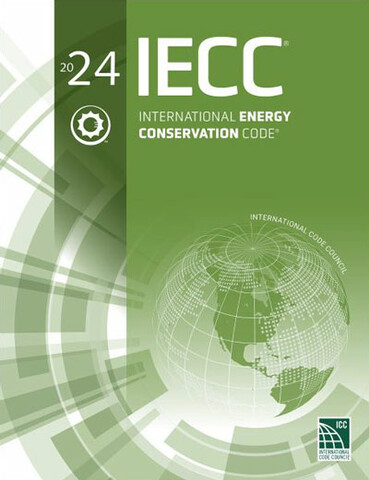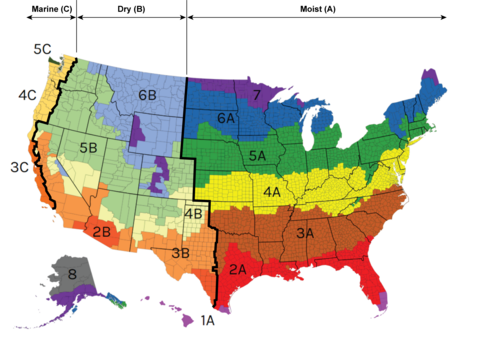
Using FPIS ci provides one of the most effective means of insulating buildings to comply with the energy code because it insulates the entire structure to minimize thermal bridging of CFS framing materials. Without FPIS ci, the cavity insulation alone will deliver about 50% (or less) of its rated R-value. Consequently, FPIS ci is generally required for energy code compliance of buildings using CFS wall construction, regardless of the compliance path used (i.e., prescriptive path or performance path using total building simulation).FPIS ci also provides one of the more robust means of satisfying the moisture control requirements of the building code (refer to STEP 3).
The amount of FPIS ci can be adjusted as needed to target minimum code or other design objectives using this calculator tool.
Alternatively, use the prescriptive CFS frame wall R-value recommendations in Table 1A or 1B below based on the 2024 edition of the International Energy Conservation Code (IECC), your building type, and your climate zone as shown in the map below.
The FPIS ci material R-value specified and the FPIS material type selected (e.g., XPS, EPS, or Polyiso) will affect the thickness of the continuous insulation layer on the exterior of the wall. This thickness may affect other construction details, such as cladding connections (see STEP 4 later). In general, FPIS ci materials offer the advantage of thinner profiles to achieve required R-values in comparison to other continuous insulation material choices.
NOTE: To address energy code whole building air leakage and air barrier requirements, refer to STEP 3 for coordination with water, vapor, and air control strategies.

Source: U.S. Department of Energy
Overview
- Determine your Climate Zone (see Figure 1 or Chapter 3 of the IECC [CE])
- For the R-value recommendations, refer to Table 1 (A) or (B) below, the locally adopted energy code, the IECC, or ASHRAE 90.1 as appropriate.
- For the prescriptive U-factor method to determine alternative R-value solutions for compliance, refer to the Steel Frame Wall Calculator.
- For the Performance or Energy Rating Index compliance methods, refer to an energy modeling or energy rating professional to determine compliance.
TABLE 1
Recommended Cold-formed Steel Frame Wall R-values for Energy Code Compliance
(A) Commercial & Group R (>3 stories) Buildings1
CLIMATE | BUILDING USE | R-VALUE OPTIONS2 |
0 and 1 | All other | R0+10ci or |
Group R | ||
2 | All other | |
Group R | R0+12.6ci or | |
3 | All other | |
Group R | ||
4 | All other | |
Group R | ||
5 and | All other | R0+15.2ci or |
Group R | ||
6 | All other | R0+17.3ci or |
Group R | ||
7 | All other | |
Group R | R0+21ci or | |
8 | All other | R0+24ci or |
Group R |
(B) One- and Two-Family Dwellings & Group R (≤ 3 stories)3
CLIMATE | R-VALUE OPTIONS2 |
0, 1 and 2 | R0+10ci or R13+4ci |
R0+R15ci or R13+8.5ci | |
3 | |
4 | R0+R20ci or R13+R14ci |
5 and | |
6 | |
7 and 8 |
Table Notes:
- R-values based on 2024 IECC-C, except as noted. These R-values were determined from U-factors calculated using the method in 2021 IECC-C Section C402.1.4.2, not the AISI S250 standard as referenced in the 2024 IECC (see note 3 below).
- The first R-value is for cavity insulation located between studs; the second value is for continuous insulation (ci) located on the exterior side of studs. Where ‘R0’ is indicated, there is no cavity insulation required.
- R-values based on 2024 IECC-R or IRC Ch. 11, except as noted. These R-value options are based on complying with the U-factors for wood frame walls in 2024 IECC-R and IRC Ch.11 to provide an equivalent solution using this calculator. The U-factors account for thermal bridging of steel framing and result in different R-values for insulation components in comparison to an otherwise similar wood frame wall assembly. The calculator uses the U-factor calculation method in 2021 IECC-C Section C402.1.4.2 for steel frame wall assemblies because the AISI S250 standard method referenced in the 2024 IECC has been found to be deficient and is being replaced with a new methodology in the 2027 IECC and ASHRAE 90.1-2025.
NEXT STEP: With the energy code compliance design and insulation package specified, proceed to STEP 2.